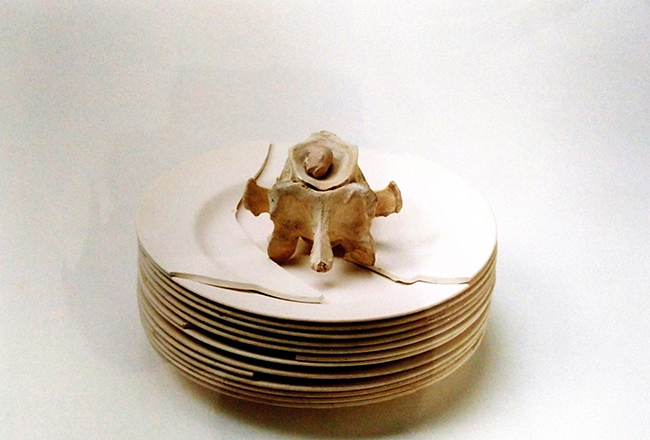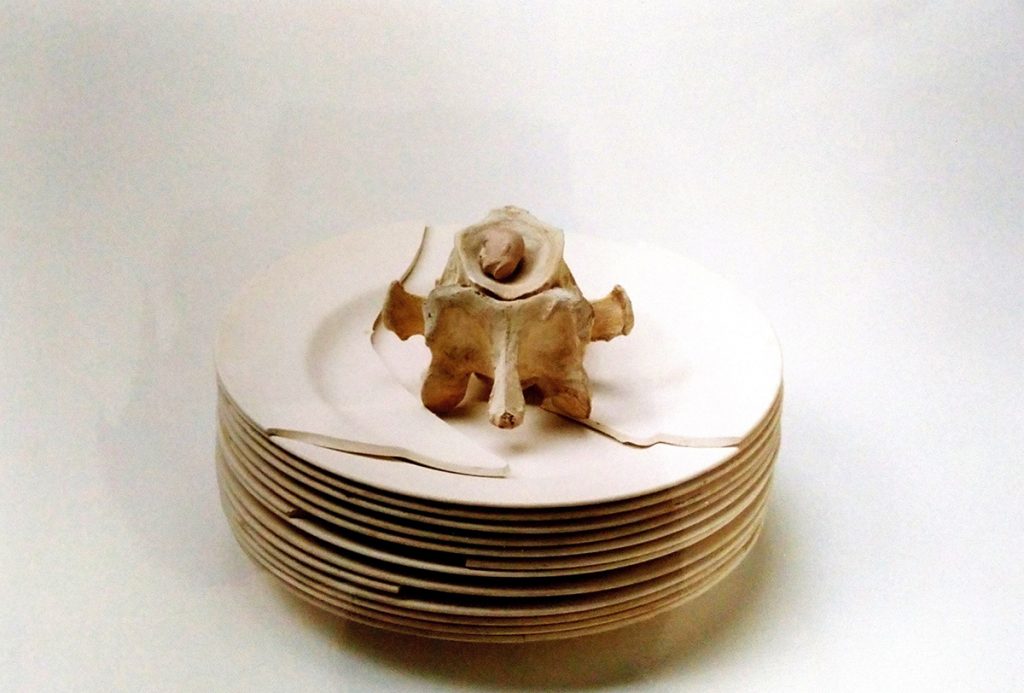Caroline Kampfraath is a Dutch artist who works in three dimensions. Her sculptures are built from objects most of us overlook—metal cans, bottles, ceramic shards, bones, and fragments of the human body cast in clay or resin. She turns these materials into narratives, binding her personal experiences with wider questions about how we live, what we consume, and what we value. Her work sits in that tension between the tangible and the symbolic, asking us to pause in a world where speed often takes priority over depth.
Kampfraath does not try to make her work neat or polished. Instead, she brings attention to what is imperfect, fragile, and temporary. Broken plates, discarded bottles, and bones become central characters in her sculptural stories. These elements point to the rhythms of daily life, but they also hold within them echoes of loss, survival, and the constant cycle between human activity and the natural world. Her work is about finding meaning in what is easily dismissed.

A Dialogue Between Object and Idea
What sets Kampfraath apart is her ability to make materials speak beyond their physical form. A can is not just an empty vessel. A shard of ceramic is not just waste. In her hands, these items become metaphors for resilience, for decay, for the way we carry memories through objects. She invites viewers to look twice at something they might otherwise throw away. In doing so, she creates a layered interpretation of human existence—how the body, the city, and the environment intersect.
Her work connects with the intimacy of human emotion as much as it does with larger social issues. By integrating symbolic objects into her sculptures, Kampfraath traces the outlines of vulnerability, dependence, and survival. It is art that moves between the personal and the universal, rooted in the Dutch tradition of material honesty while reaching outward to themes that resonate globally.
The Broken Plate Series
One of the most telling examples of her approach is her work Backbone. The piece is built from unglazed ceramic plates, deliberately left broken and imperfect. On top of this fragile surface rests the curved spine of an animal, its bone structure stark and unyielding. Within a cavity created by the plates, Kampfraath has placed a head, sculpted in repose, seemingly asleep. The work measures 35 by 25 by 25 centimeters, yet within its compact frame it opens an expansive conversation.
The broken plates represent daily life—messy, imperfect, and often precarious. They are not polished tableware meant for display but the kind that shatters in an instant. The backbone, stark against the pale ceramic, speaks to nature’s structures: the skeleton that gives form to life, the reminder that our bodies are both fragile and enduring. And then there is the sleeping head, intimate and vulnerable, resting in the cavity as though sheltered by the very materials that might otherwise cut or wound.
Kampfraath’s choice to combine these elements highlights a truth many of us prefer to ignore: how deeply dependent we are on the things we take from nature, and how unaware we often remain of this bond. The work reflects the dissonance between the urban rhythm of daily struggle and the slower, deeper patterns of the natural world. Backbone becomes a meditation on connection, fragility, and the unspoken costs of our way of life.
Layers of Meaning
Her art is rarely literal. Instead, it is suggestive, layered with associations that each viewer can unpack in their own way. The broken plate can symbolize domestic life, imperfection, or even violence. The animal bone can evoke death, survival, or the intimacy of consuming other forms of life to sustain our own. The sleeping head can suggest peace, vulnerability, or trust. By bringing these elements together, Kampfraath allows them to hold multiple truths at once.
This layered reading is what makes her work resonate. It is not just about looking but about recognizing connections: between self and environment, between waste and meaning, between fragility and resilience. Her sculptures invite slow observation, rewarding the viewer who lingers with insights that are emotional as well as intellectual.
A Broader Practice
While Backbone is one example, it reflects a broader thread in Kampfraath’s practice. She often works with found materials and sculptural fragments that carry their own histories. She lets those histories shape the work rather than hiding them. In doing so, she aligns herself with traditions of assemblage and object art, but with a clear focus on the human condition and the natural cycles that underpin it.
Her art resists easy categorization. It is not simply environmental art, nor purely personal expression. It sits somewhere in between, in the lived reality of objects and emotions. She seeks to honor imperfection, to remind us that fragility is not a weakness but a condition of life itself.
Conclusion
Caroline Kampfraath’s sculptures remind us of what we overlook. They transform the broken and discarded into carriers of meaning. They bring us back to our dependence on nature, to our vulnerability, to the intimacy of daily life that is never as neat as we wish. Through her three-dimensional work, she tells stories that are both personal and universal, crafted from the fragments that surround us all.
Her art does not seek to resolve contradictions. Instead, it holds them—city life and nature, fragility and resilience, imperfection and beauty—within the same space. In that holding, her work achieves what she sets out to do: to connect, to provoke reflection, and to show that even in the broken, there is a story worth telling.

